Indoor Rock Climbing Wall Options for Jump Centers
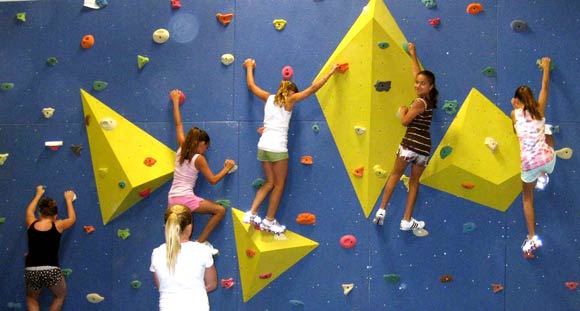
Some of you have asked about including an indoor rock climbing wall in your jump center, and it wasn’t until just recently that I had the opportunity to go to a indoor rock climbing gym, experience the fun myself, and gain some useful insight.
I spoke with the manager of the rock gym to find out more, and a few days later talked with several companies that design and build rock climbing walls. Here are the top points.
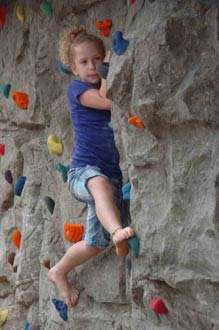 Fun for All Ages
Fun for All Ages
Contrary to what some may think, rock climbing walls are certainly not just for adults. There were a handful of kids climbing the beginner walls – these walls were just as tall, about 24+ ft tall, but included more hand and foot placement pieces and had no slopes. The tallest walls at this gym were about 35 ft tall, and included various slopes and inclines. The walls were setup to cater to all ages. They even offer youth programs, overnight lock-ins and birthday parties for up to 10 climbers for $180.
Safety and Staff
Roped climbing walls or walls with auto-belaying ropes are typically safer than bouldering walls. Bouldering walls are shorter walls usually no taller than 12 or 14 feet and do not offer the use of ropes, so if you fall – you land on the padded floor. This is when injuries can occur. Instead, with the use of ropes, the individual that is climbing can be held in place when he or she loses grip and can be safely and slowly lowered to the ground.
The gym staff was actually not involved in belaying (serving as a climbing partner and holding the rope). Instead everyone had to have someone with them that’s already certified to belay or you can use the auto-belay ropes. They do offer belay courses to get certified on site.
Auto-Belay Ropes
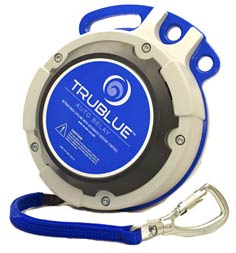 These are great – no need for a climbing partner. You simply clip the end of the rope onto your harness and climb. If you lose your grip, or when you reach the top just pull away from the wall and you’ll be lowered down slowly. Using auto-belay ropes means lower payroll cost because you don’t have to rely on staff, staff training, etc so you have less employees on the clock and less chances for mistakes caused by human error.
These are great – no need for a climbing partner. You simply clip the end of the rope onto your harness and climb. If you lose your grip, or when you reach the top just pull away from the wall and you’ll be lowered down slowly. Using auto-belay ropes means lower payroll cost because you don’t have to rely on staff, staff training, etc so you have less employees on the clock and less chances for mistakes caused by human error.
Pictured on the right is TruBlue Auto-Belay rope, the best on the market ($2195)
Security Mats
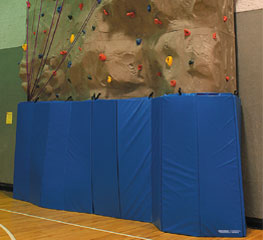 I would consider these a must for a jump center. Security mats have three purposes. When on the floor, they provide extra padding, and when folded up against the wall they prevent kids and adults from trying to climb the walls with no attendant in the arena, and lastly they will prevent kids from running into the walls and getting hurt.
I would consider these a must for a jump center. Security mats have three purposes. When on the floor, they provide extra padding, and when folded up against the wall they prevent kids and adults from trying to climb the walls with no attendant in the arena, and lastly they will prevent kids from running into the walls and getting hurt.
Security mats cost about $200 per section, depending on size and thickness.
Common Injuries
According to the manager, ankle and wrist injuries are most frequent and result from improper falling. He said they get about one injury every four months. While a broken ankle or wrist is no fun to deal with, you can minimize these injuries by installing climbing walls with ropes as opposed to free-style bouldering walls in your jump center.
Waiver of Liability
The very first thing upon entry into the gym was signing the waiver. I’ll update this post when I get a copy of the waiver I signed. For the most part it was a standard one page waiver, but the wording is always important – you should always have an attorney glance over your waiver before you start using it.
Admission Fees
Admission was $15 for a full day, and included the harness. You can also rent rock climbing shoes if you’d like for a few more bucks. When including a climbing wall in your jump center, depending on the size, it could easily be a separate service, with separate admission. Additionally you could easily offer discounts and family packages with something for everyone. While jump castles cater to younger kids, the climbing wall can be setup to attract older kids, and adults.
Climbing Wall Options and Cost
You have to shop around. In that sense this is no different than purchasing your inflatables. To give you a base idea of the cost I’ll use the figures provided by RockWerx. You have two options, you can purchase the wall in modular pieces and get a local contractor to install it at your jump center, or you can hire a company to design, engineer and install a custom wall at your facility.
The first option is of course less expansive. The modular sections are 4 by 8 feet and start at about $375 each for a simple textured finish. The price goes up with more premium finish options, up to $1195 for real rock texture. Each section comes with all the hardware needed for installation and hand/foot grips.
The second option will typically cost anywhere from $60 to $90 per square foot. You’ll have to discuss specifics to get an accurate estimate.
If you have specific questions call RockWerx at 410-238-1913 and ask to speak with Liz or Brad. They’ll be more than happy to answer all your questions.
Make it Profitable
This is important. If you make the wall big enough to be a separate attraction, you will be able to charge a separate admission fee. The easiest way to accomplish this is to install a roped climbing wall, where admission grants the customer a harness and a all day pass. You can increase profits by renting out additional items like specialty rock climbing shoes.
If you add a couple of modular pieces to one of the walls in a jump room you’re not creating a separate revenue stream, instead you’re adding more value to the open jump admission, which is still a good end result, just don’t confuse it with a option above.
Conclusion
A rock climbing wall has the potential to be an awesome addition to your indoor jump center. The bigger and taller the wall the greater the attraction it becomes, so you need ceilings tall enough to support roped climbing walls. Adding a climbing wall is a significant expense. If you’re just opening a new jump center you can add the wall later, just keep in mind where you’d like to install it as you setup the layout of your center.
Lastly, if you’ve never been rock climbing before you should definitely try it! There should be one near you, just look it up and go. And a quick tip – focus on using your legs, not just your arms, trust me.
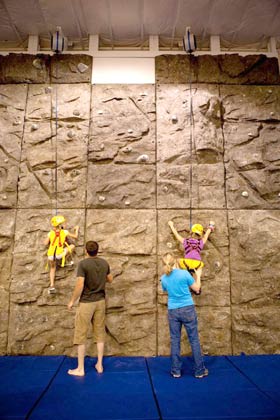
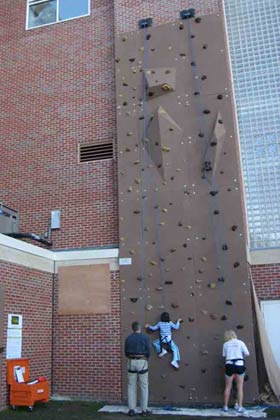
Left: Rock textured modular wall with auto-belay ropes. Right: Outdoor climbing wall
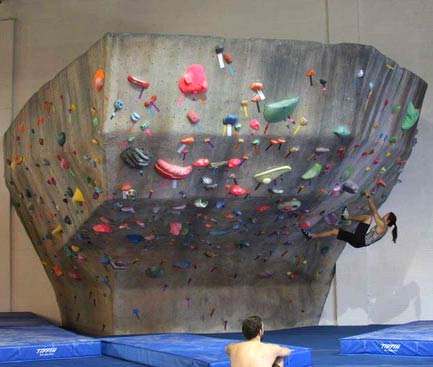
Bouldering wall with floor pads.
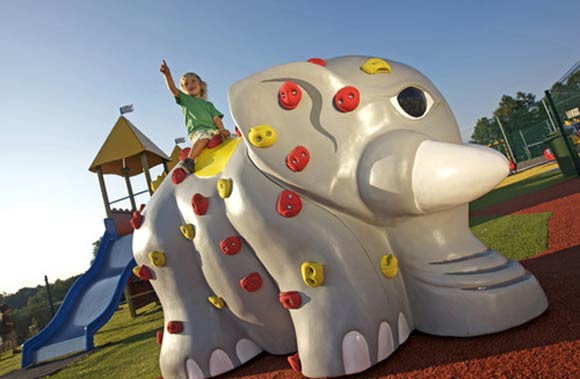
Tommy Elephant with Climbing Grips by CityWall – Indoor & Outdoor Use.







